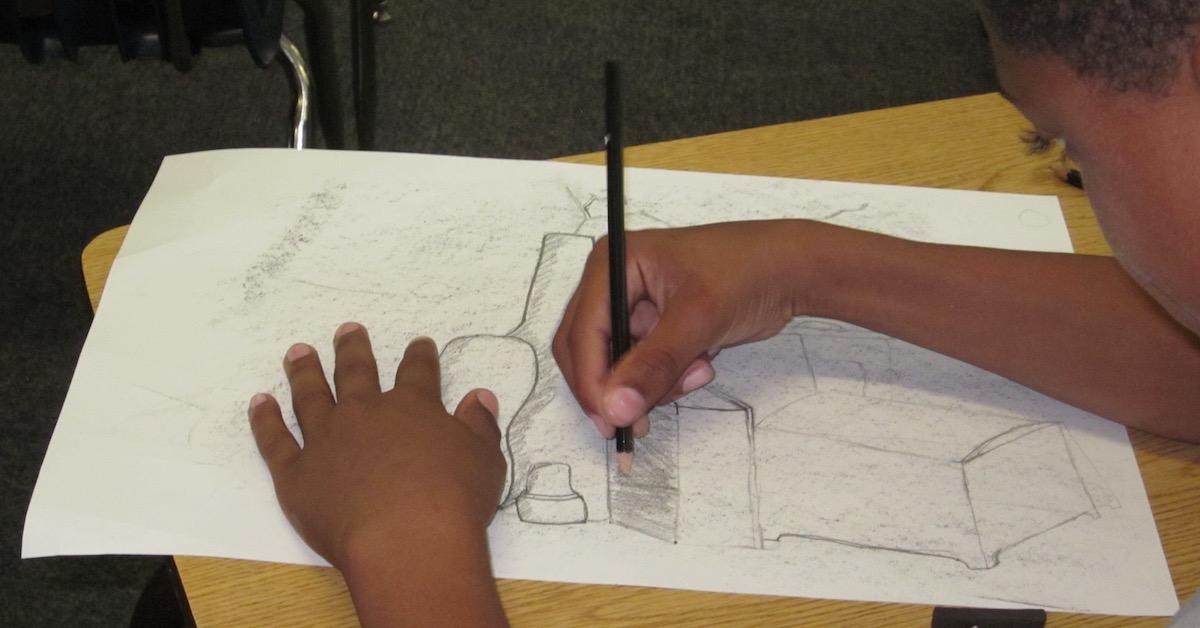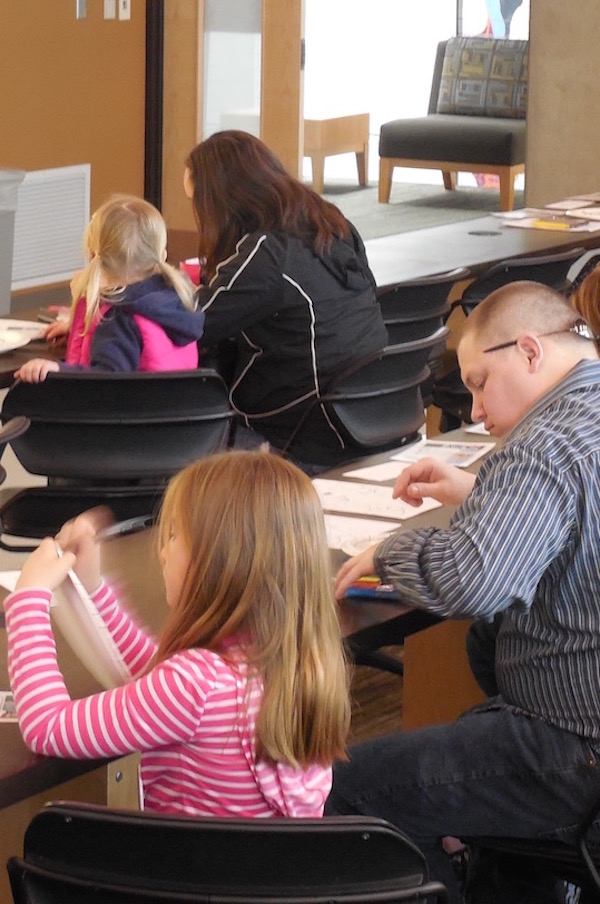Five Important Life Skills That Art Classes Teach
As I was working to create an art lesson for kids recently, making sure that concepts like
-
unity,
-
repeating motifs, and
-
balance
were clearly presented, I couldn’t help but remind myself that
an art lesson is about much more than creating a satisfying piece of art.
After all, art students probably won’t become artists, but they WILL learn valuable life skills.
Underneath all the art skills that an art class teaches, there lies another set of skills - LIFE SKILLS. For me, it’s these LIFE SKILLS that make teaching art so exciting. The list of life skills kids can learn in an art class is long, but here are three skills for a starting list:
Art Classes Teach Kids to be Makers
I got my college education learning to analyze things: Shakespeare’s plays, the cells in plant tissue, and the philosophy behind a proposition. I was learning to think critically, to take things apart in order to understand them.
But there is another kind of thinking.

Call it design thinking, or maker thinking, or creative thinking, it’s all pretty much the same thing. It’s the thinking that builds things, that creates new things. It’s inventive thinking. Art teaches this second kind of thinking very well.
Art Classes Teach Kids to be Handy
Having spent most of my life doing design work for the theater, I’ve learned to weld, create faux finishes, draft construction drawings, build things, and do some electrical wiring. I’ve learned that it’s fun to take broken things - tools, furniture, toys, whatever - and fix them. Learning the joy of using our hands is a valuable skill. One of my scenic design students, now a lawyer, paints to relax. Another is asking for a table saw for his wedding; he loves to build things. In addition, art students quickly learn that there are “tricks” to doing things more easily.

A 6th grade teacher called one day to say that it was “such a gift” for her students to learn to use their left index finger to stop their pencil when doing pencil shading with their right hand. “It made things SO much easier!” she said. Her students had made a step in learning to be handy.
Art Classes Teach Persistence
Art classes teach us to persist when we draw a line or paint a stroke that we don’t like. ArtAchieve art lessons remind kids that “if you draw a line you don’t like, draw another one you DO like. In this way “mistakes” become new and interesting problems to solve.
I was reminded of recently this while painting a flower as an example for an art lesson. I had just added a background wash to the the picture, and something seemed wrong. The wash seemed flat, the picture looked garish, and it lacked unity. All the red was in the flower, and all the green was in the surrounding areas.
What to do? The easy solution would have been to quit. But art classes teach us to persist, and in this case, as usual, the persistence paid off. After a few experiments, I decided to add orange to the wash, and suddenly the picture had unity and the green was warm and vibrant.
|

|
|
The flower with orange added to the background
|
Learning to think creatively, learning to be handy, and learning to persist are life skills that art classes teach kids whether we intend them to be taught or not. However,
-
If we remind our students that an art activity is an experiment, not merely a time to copy, and that it’s okay if the outcome surprises us,
-
If we model the joy of finding new ways to do things, and
-
If we remind students that they need to finish a project completely before they can decide whether they like it,
Then we begin to make the teaching and learning of these skills more intentional.
As I was thinking about the many life skills that art classes teach,I was reminded of a comment that a homeschooling parent recently posted about ArtAchieve art lessons. In bold letters, she wrote, “He makes mistakes!” She meant it as a compliment. What she meant was that ArtAchieve lessons show me, the author, making “mistakes” like:
-
a poor color choice, or
-
a line that wandered off in some unintended direction, etc.,
and then dealing with the mistakes. This mom’s child found my mistakes really exciting. If I could make a mistake and find a way to deal with them, so could she!
A classroom teacher had a similar experience with her students. When her students learned that there were alternate routes to solving an art problem - that there was not one “right” way - they found that their “mistakes” were no longer disasters, but that they could actually be exciting opportunities for a problem-solving adventure.
After all, one of the important life skills that art classes teach us is problem solving.
Every art project, if presented properly, is part experiment and part problem-waiting-to-be-solved. The lessons might begin with a limitation, for example, “Shade this object with only hatch lines, cross-hatches, and dots.”

The limitation in this case presents its own set of problems to be solved:
-
How will all these hatch marks and dots interact with the other lines that show details one might want to put on the object? Will the details disappear when I start making all the shading lines?
-
Do I need to use a predominance of hatch lines or dots?
-
What parts need the most shading?
-
Where will the light seem to come from?

The exciting thing is that there are no prescribed answers. To finish the drawing, we need to become problem solvers.

Another mom who is using ArtAchieve art lessons wrote that she simply can NOT draw; she has no art talent. None at all.
But that didn’t stop her from doing art lessons along side her children. Like many parents who have done art with their students, this mom discovered that not only did she learn that she COULD make art; she also learned from her own child. In fact, they became a kind of learning team.
Art classes teach us to collaborate
In other words, one of the things we learn in an art class is the skill of being able to learn from others. We see how the person beside us is solving an art problem, and we find ways to incorporate their approach into our own art project.

By collaborating -
-
Either as individuals working along side each other,
-
Or as members of a group working on a large group project,
we learn that
-
we don’t need to have all the answers, and that
-
it’s ok to admit that others know more that we do.
Seeing mistakes as opportunities and seeing other’s (sometimes superior) skills as inspiration rather than threats are important life skills. Art classes give kids an opportunity to learn these skills by practicing them.
Learn some life skills: Enjoy an art lesson today!
As I was working to create an art lesson for kids recently, making sure that concepts like
-
unity,
-
repeating motifs, and
-
balance
were clearly presented, I couldn’t help but remind myself that
an art lesson is about much more than creating a satisfying piece of art.
After all, art students probably won’t become artists, but they WILL learn valuable life skills.
Underneath all the art skills that an art class teaches, there lies another set of skills - LIFE SKILLS. For me, it’s these LIFE SKILLS that make teaching art so exciting. The list of life skills kids can learn in an art class is long, but here are three skills for a starting list:
Art Classes Teach Kids to be Makers
I got my college education learning to analyze things: Shakespeare’s plays, the cells in plant tissue, and the philosophy behind a proposition. I was learning to think critically, to take things apart in order to understand them.
But there is another kind of thinking.

Call it design thinking, or maker thinking, or creative thinking, it’s all pretty much the same thing. It’s the thinking that builds things, that creates new things. It’s inventive thinking. Art teaches this second kind of thinking very well.
Art Classes Teach Kids to be Handy
Having spent most of my life doing design work for the theater, I’ve learned to weld, create faux finishes, draft construction drawings, build things, and do some electrical wiring. I’ve learned that it’s fun to take broken things - tools, furniture, toys, whatever - and fix them. Learning the joy of using our hands is a valuable skill. One of my scenic design students, now a lawyer, paints to relax. Another is asking for a table saw for his wedding; he loves to build things. In addition, art students quickly learn that there are “tricks” to doing things more easily.

A 6th grade teacher called one day to say that it was “such a gift” for her students to learn to use their left index finger to stop their pencil when doing pencil shading with their right hand. “It made things SO much easier!” she said. Her students had made a step in learning to be handy.
Art Classes Teach Persistence
Art classes teach us to persist when we draw a line or paint a stroke that we don’t like. ArtAchieve art lessons remind kids that “if you draw a line you don’t like, draw another one you DO like. In this way “mistakes” become new and interesting problems to solve.
I was reminded of recently this while painting a flower as an example for an art lesson. I had just added a background wash to the the picture, and something seemed wrong. The wash seemed flat, the picture looked garish, and it lacked unity. All the red was in the flower, and all the green was in the surrounding areas.
What to do? The easy solution would have been to quit. But art classes teach us to persist, and in this case, as usual, the persistence paid off. After a few experiments, I decided to add orange to the wash, and suddenly the picture had unity and the green was warm and vibrant.
|

|
|
The flower with orange added to the background
|
Learning to think creatively, learning to be handy, and learning to persist are life skills that art classes teach kids whether we intend them to be taught or not. However,
-
If we remind our students that an art activity is an experiment, not merely a time to copy, and that it’s okay if the outcome surprises us,
-
If we model the joy of finding new ways to do things, and
-
If we remind students that they need to finish a project completely before they can decide whether they like it,
Then we begin to make the teaching and learning of these skills more intentional.
As I was thinking about the many life skills that art classes teach,I was reminded of a comment that a homeschooling parent recently posted about ArtAchieve art lessons. In bold letters, she wrote, “He makes mistakes!” She meant it as a compliment. What she meant was that ArtAchieve lessons show me, the author, making “mistakes” like:
-
a poor color choice, or
-
a line that wandered off in some unintended direction, etc.,
and then dealing with the mistakes. This mom’s child found my mistakes really exciting. If I could make a mistake and find a way to deal with them, so could she!
A classroom teacher had a similar experience with her students. When her students learned that there were alternate routes to solving an art problem - that there was not one “right” way - they found that their “mistakes” were no longer disasters, but that they could actually be exciting opportunities for a problem-solving adventure.
After all, one of the important life skills that art classes teach us is problem solving.
Every art project, if presented properly, is part experiment and part problem-waiting-to-be-solved. The lessons might begin with a limitation, for example, “Shade this object with only hatch lines, cross-hatches, and dots.”

The limitation in this case presents its own set of problems to be solved:
-
How will all these hatch marks and dots interact with the other lines that show details one might want to put on the object? Will the details disappear when I start making all the shading lines?
-
Do I need to use a predominance of hatch lines or dots?
-
What parts need the most shading?
-
Where will the light seem to come from?

The exciting thing is that there are no prescribed answers. To finish the drawing, we need to become problem solvers.

Another mom who is using ArtAchieve art lessons wrote that she simply can NOT draw; she has no art talent. None at all.
But that didn’t stop her from doing art lessons along side her children. Like many parents who have done art with their students, this mom discovered that not only did she learn that she COULD make art; she also learned from her own child. In fact, they became a kind of learning team.
Art classes teach us to collaborate
In other words, one of the things we learn in an art class is the skill of being able to learn from others. We see how the person beside us is solving an art problem, and we find ways to incorporate their approach into our own art project.

By collaborating -
-
Either as individuals working along side each other,
-
Or as members of a group working on a large group project,
we learn that
-
we don’t need to have all the answers, and that
-
it’s ok to admit that others know more that we do.
Seeing mistakes as opportunities and seeing other’s (sometimes superior) skills as inspiration rather than threats are important life skills. Art classes give kids an opportunity to learn these skills by practicing them.
Learn some life skills: Enjoy an art lesson today!
As I was working to create an art lesson for kids recently, making sure that concepts like
-
unity,
-
repeating motifs, and
-
balance
were clearly presented, I couldn’t help but remind myself that
an art lesson is about much more than creating a satisfying piece of art.
After all, art students probably won’t become artists, but they WILL learn valuable life skills.
Underneath all the art skills that an art class teaches, there lies another set of skills - LIFE SKILLS. For me, it’s these LIFE SKILLS that make teaching art so exciting. The list of life skills kids can learn in an art class is long, but here are three skills for a starting list:
Art Classes Teach Kids to be Makers
I got my college education learning to analyze things: Shakespeare’s plays, the cells in plant tissue, and the philosophy behind a proposition. I was learning to think critically, to take things apart in order to understand them.
But there is another kind of thinking.

Call it design thinking, or maker thinking, or creative thinking, it’s all pretty much the same thing. It’s the thinking that builds things, that creates new things. It’s inventive thinking. Art teaches this second kind of thinking very well.
Art Classes Teach Kids to be Handy
Having spent most of my life doing design work for the theater, I’ve learned to weld, create faux finishes, draft construction drawings, build things, and do some electrical wiring. I’ve learned that it’s fun to take broken things - tools, furniture, toys, whatever - and fix them. Learning the joy of using our hands is a valuable skill. One of my scenic design students, now a lawyer, paints to relax. Another is asking for a table saw for his wedding; he loves to build things. In addition, art students quickly learn that there are “tricks” to doing things more easily.

A 6th grade teacher called one day to say that it was “such a gift” for her students to learn to use their left index finger to stop their pencil when doing pencil shading with their right hand. “It made things SO much easier!” she said. Her students had made a step in learning to be handy.
Art Classes Teach Persistence
Art classes teach us to persist when we draw a line or paint a stroke that we don’t like. ArtAchieve art lessons remind kids that “if you draw a line you don’t like, draw another one you DO like. In this way “mistakes” become new and interesting problems to solve.
I was reminded of recently this while painting a flower as an example for an art lesson. I had just added a background wash to the the picture, and something seemed wrong. The wash seemed flat, the picture looked garish, and it lacked unity. All the red was in the flower, and all the green was in the surrounding areas.
What to do? The easy solution would have been to quit. But art classes teach us to persist, and in this case, as usual, the persistence paid off. After a few experiments, I decided to add orange to the wash, and suddenly the picture had unity and the green was warm and vibrant.
|

|
|
The flower with orange added to the background
|
Learning to think creatively, learning to be handy, and learning to persist are life skills that art classes teach kids whether we intend them to be taught or not. However,
-
If we remind our students that an art activity is an experiment, not merely a time to copy, and that it’s okay if the outcome surprises us,
-
If we model the joy of finding new ways to do things, and
-
If we remind students that they need to finish a project completely before they can decide whether they like it,
Then we begin to make the teaching and learning of these skills more intentional.
As I was thinking about the many life skills that art classes teach,I was reminded of a comment that a homeschooling parent recently posted about ArtAchieve art lessons. In bold letters, she wrote, “He makes mistakes!” She meant it as a compliment. What she meant was that ArtAchieve lessons show me, the author, making “mistakes” like:
-
a poor color choice, or
-
a line that wandered off in some unintended direction, etc.,
and then dealing with the mistakes. This mom’s child found my mistakes really exciting. If I could make a mistake and find a way to deal with them, so could she!
A classroom teacher had a similar experience with her students. When her students learned that there were alternate routes to solving an art problem - that there was not one “right” way - they found that their “mistakes” were no longer disasters, but that they could actually be exciting opportunities for a problem-solving adventure.
After all, one of the important life skills that art classes teach us is problem solving.
Every art project, if presented properly, is part experiment and part problem-waiting-to-be-solved. The lessons might begin with a limitation, for example, “Shade this object with only hatch lines, cross-hatches, and dots.”

The limitation in this case presents its own set of problems to be solved:
-
How will all these hatch marks and dots interact with the other lines that show details one might want to put on the object? Will the details disappear when I start making all the shading lines?
-
Do I need to use a predominance of hatch lines or dots?
-
What parts need the most shading?
-
Where will the light seem to come from?

The exciting thing is that there are no prescribed answers. To finish the drawing, we need to become problem solvers.

Another mom who is using ArtAchieve art lessons wrote that she simply can NOT draw; she has no art talent. None at all.
But that didn’t stop her from doing art lessons along side her children. Like many parents who have done art with their students, this mom discovered that not only did she learn that she COULD make art; she also learned from her own child. In fact, they became a kind of learning team.
Art classes teach us to collaborate
In other words, one of the things we learn in an art class is the skill of being able to learn from others. We see how the person beside us is solving an art problem, and we find ways to incorporate their approach into our own art project.

By collaborating -
-
Either as individuals working along side each other,
-
Or as members of a group working on a large group project,
we learn that
-
we don’t need to have all the answers, and that
-
it’s ok to admit that others know more that we do.
Seeing mistakes as opportunities and seeing other’s (sometimes superior) skills as inspiration rather than threats are important life skills. Art classes give kids an opportunity to learn these skills by practicing them.
Learn some life skills: Enjoy an art lesson today!








